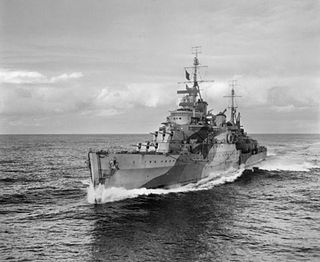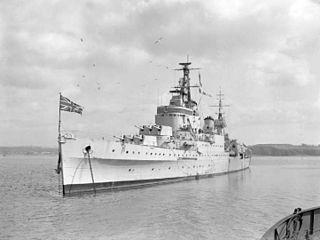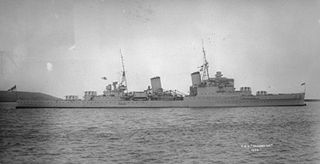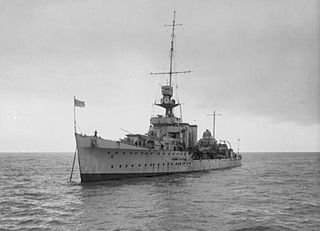
HMS Liverpool, named after the port city of Liverpool in north-west England, was a Town-class light cruiser of the Royal Navy in service from 1938 to 1952.

HMS Newcastle was a member of the Southampton subclass of the Town-class light cruiser of the Royal Navy.

HMS Manchester was a Town-class light cruiser built for the Royal Navy in the late 1930s, one of three ships in the Gloucester subclass. Completed in 1938, she was initially deployed with the East Indies Station and had a relatively short but active career. When World War II began in September 1939, the cruiser began escorting convoys in the Indian Ocean until she was ordered home two months later. In late December Manchester began conducting patrols in the Norwegian Sea enforcing the blockade of Germany. Beginning in April 1940 the ship played a minor role in the Norwegian Campaign, mostly escorting convoys. She was assigned to anti-invasion duties in May–November in between refits.

HMS Fiji was the lead ship of her class of 11 light cruisers built for the Royal Navy shortly before the Second World War. Completed in mid-1940, she was initially assigned to the Home Fleet and was detached to escort a force tasked to force French West Africa to join the Free French. The ship was torpedoed en route and required six months to be repaired. Fiji was then assigned to Force H where she helped to escort convoys to Malta. The ship was transferred to the Mediterranean Fleet in early May 1941. After the Germans invaded Crete a few weeks later, she was sunk by German aircraft on 22 May after having fired off all of her anti-aircraft ammunition.

HMS Jamaica, a Fiji-class cruiser of the Royal Navy, was named after the island of Jamaica, which was a British Crown Colony when she was built in the late 1930s. The light cruiser spent almost her entire wartime career on Arctic convoy duties, except for a deployment south for the landings in North Africa in November 1942. She participated in the Battle of the Barents Sea in 1942 and the Battle of North Cape in 1943. Jamaica escorted several aircraft carriers in 1944 as they flew off airstrikes that attacked the German battleship Tirpitz in northern Norway. Late in the year she had an extensive refit to prepare her for service with the British Pacific Fleet, but the war ended before she reached the Pacific.

HMS Glasgow was a Town-class cruiser commissioned in September 1937. She took part in the Fleet Air Arm raid that crippled the Italian Fleet at Taranto in 1940. She had the unfortunate experience of sinking two Allied ships during her wartime service, once through accidental collision and the other by gunfire after a case of mistaken identity.

HMS Gurkha was a Tribal-class destroyer that saw active service in the Norway Campaign in 1940, where she was sunk.

HMS Kent, pennant number 54, was a County-class heavy cruiser built for the Royal Navy in the late 1920s. She was the lead ship of the Kent subclass. After completion the ship was sent to the China Station where she remained until the beginning of the Second World War, aside from a major refit in 1937–38. Kent hunted the German pocket battleship Admiral Graf Spee in the East Indies in late 1939 and then was reassigned to troop convoy escort duties in the Indian Ocean in early 1940. She was transferred to the Mediterranean in mid-1940, but was torpedoed shortly after arriving. The ship was under repair for a year and was then assigned to Home Fleet where she escorted convoys to and from North Russia for the next several years. In mid-1944 Kent escorted British aircraft carriers as their aircraft made attacks on German shipping and airfields in Norway. A few months later she was flagship of a force that intercepted a German convoy in Norwegian waters and sank two freighters and five escorts. The ship was paid off in early 1945 and placed in reserve until she was used as a target. Kent was sold for scrap in 1948.

HMS Edinburgh was a Town-class light cruiser of the Royal Navy, which served during the Second World War. She was one of the last two Town class cruisers, which formed the Edinburgh sub-class. Edinburgh saw a great deal of combat service during the Second World War, especially in the North Sea and the Arctic Sea, where she was sunk by torpedoes in 1942.

HMS Penelope was an Arethusa-class light cruiser of the Royal Navy. She was built by Harland & Wolff ; her keel was laid down on 30 May 1934. She was launched on 15 October 1935, and commissioned 13 November 1936. She was torpedoed and sunk by the German U-boat U-410 near Naples with great loss of life on 18 February 1944. On wartime service with Force K, she was holed so many times by bomb fragments that she acquired the nickname "HMS Pepperpot".

HMS Sussex was one of the London sub-class of the County-class heavy cruisers in the Royal Navy. She was laid down by R. and W. Hawthorn, Leslie and Company, Limited, at Hebburn-on-Tyne on 1 February 1927, launched on 22 February 1928 and completed on 19 March 1929.

HMS Bonaventure was the lead ship of the Dido-class light cruisers built for the Royal Navy (RN) during the 1930s and during the Second World War. Completed in 1940, Bonaventure was assigned to the Home Fleet and participated in Operation Fish, the evacuation of British wealth from the UK to Canada in July. The ship made one short patrol in August into the North Atlantic to search for German blockade runners and followed that up by escorting an aircraft carrier as it conducted air strikes in Southern Norway in September. The next month she was tasked to provide cover for anti-shipping raids off the Norwegian coast. Bonaventure participated in the unsuccessful search for the German commerce raider Admiral Scheer in November and sustained weather damage that caused her to spend time in a dockyard for repairs. She was part of the escort force for Convoy WS 5A in December and helped to drive off another German commerce raider. While searching for stragglers from the convoy, the cruiser sank a German blockade runner.

HMS York was the lead ship of her class of two heavy cruisers built for the Royal Navy in the late 1920s. She mostly served on the North America and West Indies Station before World War II. Early in the war the ship escorted convoys in the Atlantic and participated in the Norwegian Campaign in 1940. York was transferred to the Mediterranean theatre in late 1940 where she escorted convoys and the larger ships of the Mediterranean Fleet. She was wrecked in an attack by Italian explosive motorboats of the 10th Flotilla MAS at Suda Bay, Crete, in March 1941. The ship's wreck was salvaged in 1952 and subsequently scrapped.

HMS Cleopatra was a Dido-class cruiser of the Royal Navy. She was built by R. and W. Hawthorn, Leslie and Company, Limited, with the keel being laid down on 5 January 1939. She was launched on 27 March 1940, and commissioned on 5 December 1941.

HMS Hermione was a Dido-class light cruiser of the Royal Navy. She was built by Alexander Stephen and Sons, with the keel laid down on 6 October 1937. She was launched on 18 May 1939 and commissioned 25 March 1941. On 16 June 1942, Hermione was torpedoed and sunk by the German submarine U-205 in the Mediterranean. Eighty-eight crewmembers were killed.

HMS Sirius was a Dido-class light cruiser of the Royal Navy. She was built by Portsmouth Dockyard, with the keel being laid down on 6 April 1938. She was launched on 18 September 1940, and commissioned 6 May 1942.

HMS Birmingham was a member of the first group of five ships of the Town class light cruisers.

HMS Gloucester was one of the second batch of three Town-class light cruisers built for the Royal Navy during the late 1930s. Commissioned shortly before the start of World War II in August 1939, the ship was initially assigned to the China Station and was transferred to the Indian Ocean and later to South Africa to search for German commerce raiders. She was transferred to the Mediterranean Fleet in mid-1940 and spent much of her time escorting Malta Convoys. Gloucester played minor roles in the Battle of Calabria in 1940 and the Battle of Cape Matapan in 1941. She was sunk by German dive bombers on 22 May 1941 during the Battle of Crete with the loss of 722 men out of a crew of 807. Gloucester acquired the nickname "The Fighting G" after earning five battle honours in less than a year.

HMS Mashona was one of 16 Tribal-class destroyers built for the Royal Navy shortly before the beginning of Second World War in 1939. Completed in that year, she was assigned to the Home Fleet. During the first year of the war, the ship was on convoy escort duties. Mashona played an active role in the Norwegian Campaign of April–May 1940, escorting convoys to and from Norway. The ship helped to briefly seize four Swedish warships en route from Italy to Sweden in June 1940 and resumed her role of convoy escort after their release in July. She accidentally collided with one of her sister ships in early 1941 and spent several months under repair.

HMS Calcutta was a C-class light cruiser of the Royal Navy, named after the Indian city of Calcutta. She was part of the Carlisle group of the C class of cruisers. She was laid down by Vickers Limited at Barrow-in-Furness in 1917 and launched on 9 July 1918. Calcutta was commissioned too late to see action in the First World War and was converted to an anti-aircraft cruiser in 1939. Calcutta served during the Norwegian Campaign and the evacuation from Dunkirk in 1940. She was used to escort allied convoys across the Mediterranean and was sunk on 1 June 1941 by Luftwaffe aircraft off Alexandria, Egypt.




















